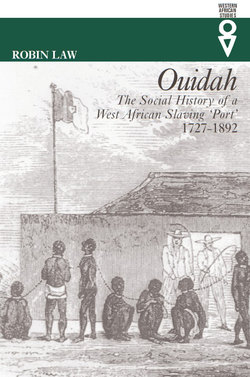Читать книгу Ouidah - Robin Law - Страница 9
На сайте Литреса книга снята с продажи.
ОглавлениеAcknowledgements
Illustrations on chapter openings: based on an appliqué cloth representing the history of Ouidah, Historical Museum at Ouidah
The project of writing a history of Ouidah was initially conceived in 1991 and took on more concrete shape in a visit to the Republic of Bénin in January 1992. That it has finally come to fruition is the result of generous assistance received from numerous institutions and individuals, for which acknowledgement is gratefully made.
Among the many institutions that have contributed to the realization of the project, thanks are due first to the University of Stirling, not only for maintaining me in gainful employment, but more particularly for the grant of sabbatical leave in the autumn semester of 2001, when much of the final work of writing was done. During the academic session 2000/01 I held a visiting position at the Hebrew University of Jerusalem, when much of my time was likewise devoted to this work; my thanks to the Lady Davis Fellowship Trust and the Harry S. Truman Research Institute of the Hebrew University for their support in this period. Other institutions that in various ways have supported and assisted the research, especially by the promotion of collaborative networks for the exchange of ideas and information, from which it has benefited enormously, are the Nigerian Hinterland Project at York University, Toronto (and, through its funding of this project, the Social Sciences and Humanities Research Council of Canada), and the UNESCO Slave Route Project.
Research was undertaken in several archives and libraries, to whose staff grateful thanks are recorded: notably the libraries of the University of Stirling and the School of Oriental and African Studies, London; the Public Record Office, London; the Archives Nationales, Section d’Outre-Mer, Aix-en-Provence; the Centre de Documentation de la Faculté des Arts et Sciences Humaines of the Université Nationale du Bénin, Abomey-Calavi, and the Archives Nationales, Porto-Novo, in Bénin. Although the research has been mainly based on work in archives overseas, it also critically depended on several visits to Bénin, not only to work in local archives but also to collect oral information in Ouidah and more generally for discussions with local scholars; my gratitude is due therefore to those institutions that gave financial support for some of these visits, notably the Faculty of Arts and the Department of History of the University of Stirling, for visits in 1992, 1996 and 2001, and UNESCO, for a visit in 1994.
The individuals who have contributed to this work are too numerous for all to be acknowledged here by name, but there are some to whom my debts are so great as to require explicit mention. First, I must make clear my indebtedness to earlier researchers in the field, upon whose work I have depended even when my own conclusions have sometimes differed: especially important has been the work of Ouidah’s leading local historian, Casimir Agbo, while among modern academic scholars, particular acknowledgement is due to Ade Akinjogbin, Edna Bay, Patrick Manning, John Reid, David Ross, Elisée Soumonni and Jerry Michael Turner. For their generosity in supplying ideas, material and information, special mention should be made of Edna Bay, Suzanne Preston Blier, Alberto da Costa e Silva, Léopold David-Gnahoui, Félix Iroko, Adam Jones, Kristin Mann and Elisée Soumonni; for assistance in tracking down and verifying particular references, I thank Olatunji Ojo and Silke Strickrodt; and for reading and commenting on a preliminary draft of this work, Ella Keren, Paul Lovejoy, Martin Lynn and David Richardson. For her assistance as guide and interpreter in several visits to Ouidah, as well as for sharing her profound local knowledge, my thanks to Martine de Souza. For their generous hospitality and other practical assistance in Bénin, I am deeply grateful to Elisée and Maria Soumonni and Obarè and Maryamou Bagodo.
This book is not offered with any pretensions to represent the final word on the history of Ouidah. There is space, and indeed need, for much further work, especially (although certainly not exclusively) in areas and periods where my own firsthand research has been restricted, including French archival sources for the nineteenth century, Portuguese and Brazilian sources more generally and the period of Ouidah’s transition from Dahomian to French rule in the late nineteenth and early twentieth centuries. I hope that those who work on Ouidah in future will enjoy the experience, and especially working in the town itself, as much as myself.
